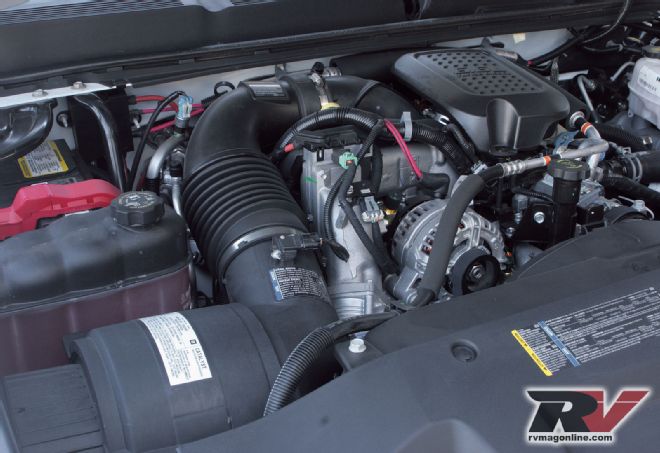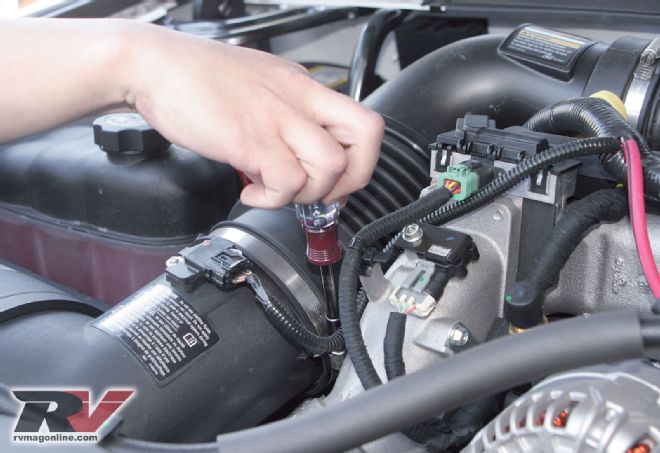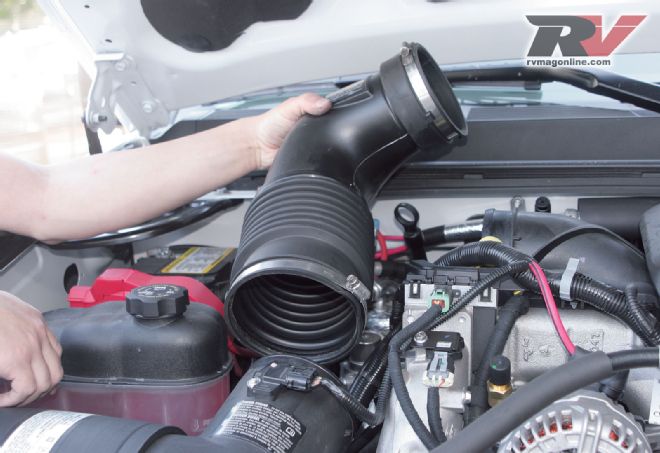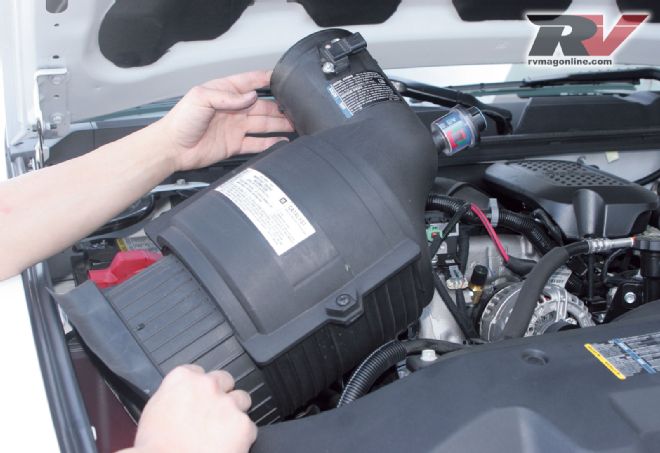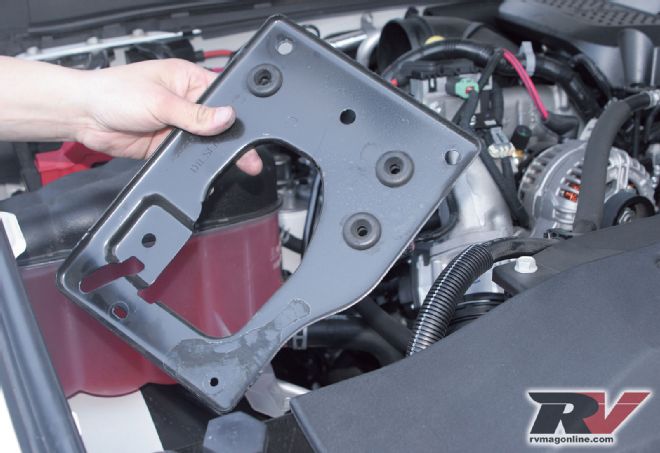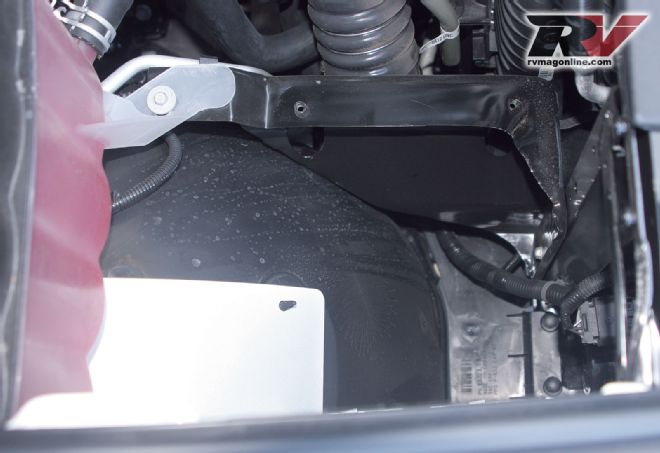Duramax Diesel Performance Intake - Keeping Your Cool
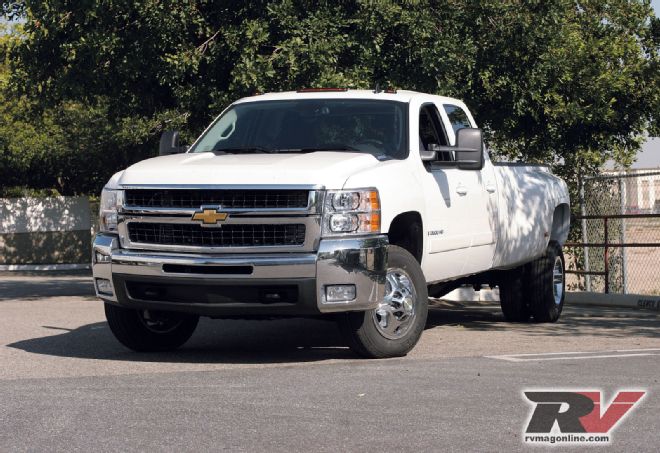
| Adding additional performance and fuel economy to a 2008 GM HD truck has more to do with keeping the air inlet temperatures cool and clean.
It's a known fact that additional air can provide improvements in engine performance and fuel efficiency. But most truck owners don't realize that the quality and temperature of the air has a lot more to do with achieving additional performance gains. This is especially true on turbocharged diesel engines that are sensitive to air inlet temperatures.
Air inlet temperatures have a large influence over boost levels. The hotter the air is when it enters the intake system to the turbo, the less efficient the engine's combustion process becomes and, ultimately, power suffers. This is one of the reasons why turbo diesels use intercoolers as a method of lowering air inlet temperatures. But aside from cooler air, it is also very important to diesel owners that the air be filtered properly. A high-flowing filter that doesn't catch small particles of dirt can lead to premature wear and ultimately engine failure.
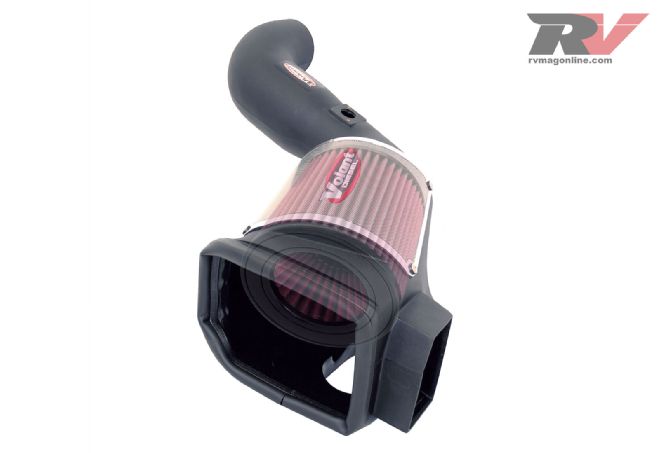
| 0812rv 01 Duramax Diesel Performance Intake Volant Air Intake System
It's because of these reasons that many diesel owners like using a sealed cold air intake system. Sealed intake systems not only prevent incoming air from being contaminated by engine heat, they also block out any chance of hot air forcing its way in. On the 6.6-liter Duramax, for example, this can happen when auxiliary electric cooling fans switch on, pull hot air through the radiator and force it around the heat shields of some open-element air intake systems.
Aftermarket air intake manufacturers such as Volant Performance see this scenario happen all the time and design their systems to avoid both heat contamination and to improve filtration while providing additional volumes of air to improve engine efficiency.
Installing a sealed cold air intake system, such as the Volant, is a simple task that also demonstrates the measures taken to avoid heat and to properly feed the engine larger amounts of cleaner air. Replacing the factory system is done by simply loosening the factory clamps on the intake duct to remove it. The factory air filter box simply pulls out from its position on top of the inner fender, clearing the way for one that can hold a larger volume of air.
Because the Volant system grabs air from three locations, it is also necessary to remove the factory filter box plate. This is done to provide room for the bottom opening that allows the Volant filter box to gather cold air from underneath. The box also gathers air from the side of the fender and from an opening in the radiator core support to capture air that won't be contaminated by engine heat or auxiliary fans blowing into the system.
Volant also uses its ProGuard-7 filter element that features a higher flow rate than the factory air filter element but also adds improved filtration. Volant's ProGuard-7 filter uses seven layers of cotton/gauze and features a large conical shape that also has an inverted cone at one end. This design provides a much larger surface area to improve filtration and airflow.
The Volant system attaches to the GM 6.6-liter using silicone sleeve couplers and stainless steel clamps. The factory mass airflow meter is also transferred from the factory intake and is placed onto the high-flow Volant intake tube with the provided hardware. Once the system is installed, the new air filter is sealed with a nicely polished stainless steel lid that features the Volant logo.
The entire installation takes about 20 minutes, and the difference in performance is noticeable. Furthermore, substantial power gains can be made by including an aftermarket exhaust system. As an example, this intake system on a 2006-model Chevy HD that was also equipped with a Volant high-flow exhaust yielded 45 additional rear-wheel horsepower on the dyno with no other changes. Those are impressive numbers, but keep in mind that much of this was due to the fact that the sealed intake system was able to keep the air inlet temperatures low and flow more of it. So keep in mind that it's not always about how much air flows through your engine, it's also about keeping it cool and clean.
 | Adding additional performance and fuel economy to a 2008 GM HD truck has more to do with keeping the air inlet temperatures cool and clean.
It's a known fact that additional air can provide improvements in engine performance and fuel efficiency. But most truck owners don't realize that the quality and temperature of the air has a lot more to do with achieving additional performance gains. This is especially true on turbocharged diesel engines that are sensitive to air inlet temperatures.
Air inlet temperatures have a large influence over boost levels. The hotter the air is when it enters the intake system to the turbo, the less efficient the engine's combustion process becomes and, ultimately, power suffers. This is one of the reasons why turbo diesels use intercoolers as a method of lowering air inlet temperatures. But aside from cooler air, it is also very important to diesel owners that the air be filtered properly. A high-flowing filter that doesn't catch small particles of dirt can lead to premature wear and ultimately engine failure.
| Adding additional performance and fuel economy to a 2008 GM HD truck has more to do with keeping the air inlet temperatures cool and clean.
It's a known fact that additional air can provide improvements in engine performance and fuel efficiency. But most truck owners don't realize that the quality and temperature of the air has a lot more to do with achieving additional performance gains. This is especially true on turbocharged diesel engines that are sensitive to air inlet temperatures.
Air inlet temperatures have a large influence over boost levels. The hotter the air is when it enters the intake system to the turbo, the less efficient the engine's combustion process becomes and, ultimately, power suffers. This is one of the reasons why turbo diesels use intercoolers as a method of lowering air inlet temperatures. But aside from cooler air, it is also very important to diesel owners that the air be filtered properly. A high-flowing filter that doesn't catch small particles of dirt can lead to premature wear and ultimately engine failure.
 | 0812rv 01 Duramax Diesel Performance Intake Volant Air Intake System
It's because of these reasons that many diesel owners like using a sealed cold air intake system. Sealed intake systems not only prevent incoming air from being contaminated by engine heat, they also block out any chance of hot air forcing its way in. On the 6.6-liter Duramax, for example, this can happen when auxiliary electric cooling fans switch on, pull hot air through the radiator and force it around the heat shields of some open-element air intake systems.
Aftermarket air intake manufacturers such as Volant Performance see this scenario happen all the time and design their systems to avoid both heat contamination and to improve filtration while providing additional volumes of air to improve engine efficiency.
Installing a sealed cold air intake system, such as the Volant, is a simple task that also demonstrates the measures taken to avoid heat and to properly feed the engine larger amounts of cleaner air. Replacing the factory system is done by simply loosening the factory clamps on the intake duct to remove it. The factory air filter box simply pulls out from its position on top of the inner fender, clearing the way for one that can hold a larger volume of air.
Because the Volant system grabs air from three locations, it is also necessary to remove the factory filter box plate. This is done to provide room for the bottom opening that allows the Volant filter box to gather cold air from underneath. The box also gathers air from the side of the fender and from an opening in the radiator core support to capture air that won't be contaminated by engine heat or auxiliary fans blowing into the system.
Volant also uses its ProGuard-7 filter element that features a higher flow rate than the factory air filter element but also adds improved filtration. Volant's ProGuard-7 filter uses seven layers of cotton/gauze and features a large conical shape that also has an inverted cone at one end. This design provides a much larger surface area to improve filtration and airflow.
The Volant system attaches to the GM 6.6-liter using silicone sleeve couplers and stainless steel clamps. The factory mass airflow meter is also transferred from the factory intake and is placed onto the high-flow Volant intake tube with the provided hardware. Once the system is installed, the new air filter is sealed with a nicely polished stainless steel lid that features the Volant logo.
The entire installation takes about 20 minutes, and the difference in performance is noticeable. Furthermore, substantial power gains can be made by including an aftermarket exhaust system. As an example, this intake system on a 2006-model Chevy HD that was also equipped with a Volant high-flow exhaust yielded 45 additional rear-wheel horsepower on the dyno with no other changes. Those are impressive numbers, but keep in mind that much of this was due to the fact that the sealed intake system was able to keep the air inlet temperatures low and flow more of it. So keep in mind that it's not always about how much air flows through your engine, it's also about keeping it cool and clean.
| 0812rv 01 Duramax Diesel Performance Intake Volant Air Intake System
It's because of these reasons that many diesel owners like using a sealed cold air intake system. Sealed intake systems not only prevent incoming air from being contaminated by engine heat, they also block out any chance of hot air forcing its way in. On the 6.6-liter Duramax, for example, this can happen when auxiliary electric cooling fans switch on, pull hot air through the radiator and force it around the heat shields of some open-element air intake systems.
Aftermarket air intake manufacturers such as Volant Performance see this scenario happen all the time and design their systems to avoid both heat contamination and to improve filtration while providing additional volumes of air to improve engine efficiency.
Installing a sealed cold air intake system, such as the Volant, is a simple task that also demonstrates the measures taken to avoid heat and to properly feed the engine larger amounts of cleaner air. Replacing the factory system is done by simply loosening the factory clamps on the intake duct to remove it. The factory air filter box simply pulls out from its position on top of the inner fender, clearing the way for one that can hold a larger volume of air.
Because the Volant system grabs air from three locations, it is also necessary to remove the factory filter box plate. This is done to provide room for the bottom opening that allows the Volant filter box to gather cold air from underneath. The box also gathers air from the side of the fender and from an opening in the radiator core support to capture air that won't be contaminated by engine heat or auxiliary fans blowing into the system.
Volant also uses its ProGuard-7 filter element that features a higher flow rate than the factory air filter element but also adds improved filtration. Volant's ProGuard-7 filter uses seven layers of cotton/gauze and features a large conical shape that also has an inverted cone at one end. This design provides a much larger surface area to improve filtration and airflow.
The Volant system attaches to the GM 6.6-liter using silicone sleeve couplers and stainless steel clamps. The factory mass airflow meter is also transferred from the factory intake and is placed onto the high-flow Volant intake tube with the provided hardware. Once the system is installed, the new air filter is sealed with a nicely polished stainless steel lid that features the Volant logo.
The entire installation takes about 20 minutes, and the difference in performance is noticeable. Furthermore, substantial power gains can be made by including an aftermarket exhaust system. As an example, this intake system on a 2006-model Chevy HD that was also equipped with a Volant high-flow exhaust yielded 45 additional rear-wheel horsepower on the dyno with no other changes. Those are impressive numbers, but keep in mind that much of this was due to the fact that the sealed intake system was able to keep the air inlet temperatures low and flow more of it. So keep in mind that it's not always about how much air flows through your engine, it's also about keeping it cool and clean.
